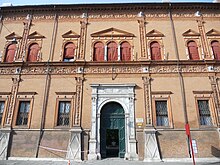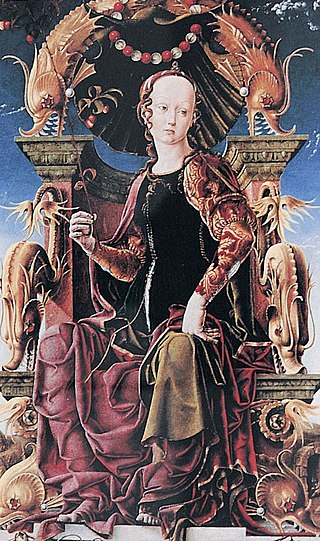
Cosmê Tura, also known as Il Cosmè or Cosimo Tura, was an Italian early-Renaissance painter and considered one of the founders of the School of Ferrara.

Palazzo Schifanoia is a Renaissance palace in Ferrara, Emilia-Romagna (Italy) built for the Este family. The name "Schifanoia" is thought to originate from "schivar la noia" meaning literally to "escape from boredom" which describes accurately the original intention of the palazzo and the other villas in close proximity where the Este court relaxed. The highlights of its decorations are the allegorical frescoes with details in tempera by or after Francesco del Cossa and Cosmè Tura, executed ca 1469–70, a unique survival of their time.

Palazzo dei Diamanti is a Renaissance palace located on Corso Ercole I d'Este 21 in Ferrara, region of Emilia Romagna, Italy. The main floor of the Palace houses the Pinacoteca Nazionale di Ferrara.

Château Grimaldi at Puyricard near Aix-en-Provence is a mansion built within the ruined walls of a 16th-century Château once belonging to the Archbishops of Puyricard. The original castle chapel remains built in the Romanesque style. Between 1655 and 1685 the château served as residence of Cardinal Archbishop Girolamo Grimaldi-Cavalleroni who had rebuilt the chateau which had been in ruins for 70 years. As the residence of an archbishop the ruined Château is sometimes referred to as an episcopal palace. The term "palace" for any residence, no matter how large, other than episcopal is not commonly used in Europe for any rural building.
The Biblioteca Comunale Ariostea is located in the Palazzo Paradiso in central Ferrara, region of Emilia-Romagna, Italy. It was named Ariostea, because the collection contains manuscripts related to the author, and within the palace also lies the tomb of Ludovico Ariosto.

Palazzo Cocchi-Serristori is a Renaissance-style palace in Piazza Santa Croce, Florence, Italy. It presently houses offices of a regional council of Florence.

The Palazzo Bentivoglio is a late-Renaissance palace located on Via Garibaldi in central Ferrara, Region of Emilia-Romagna, Italy
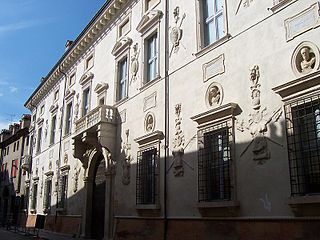
The Palazzo Bevilacqua-Costabili is a Renaissance palace located on Via Voltapaletto 11 in central Ferrara, Region of Emilia-Romagna, Italy. It should not be confused with the Palazzo Bevilacqua in Verona, designed by Michele Sanmicheli.
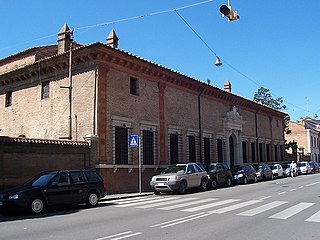
The Palazzina Marfisa d'Este is a Renaissance-style small palace, once suburban, and sometimes referred to as a villa, located on Corso Giovecca #170, just east of Central Ferrara, region of Emilia-Romagna, Italy. It was constructed in 1559 by the peripatetic Francesco d'Este, and inherited by his daughter, Marfisa in 1578.

The Palazzo Bonacossi is a Renaissance architecture palace located on Via Cisterna del Follo #5 in Ferrara, Italy. The 15th-century palace is the home of the Musei Civici di Arte Antica e Museo Riminaldi.
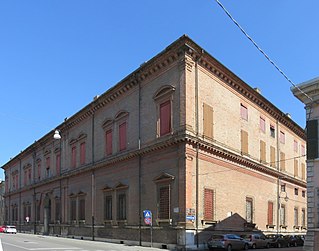
The Palazzo Massari, also known as the Palazzo Rosso, is a Renaissance-style palace located on Borso and Corso Porta Mare, at the northwest corner of Piazza Ariostea, in Ferrara, region of Emilia-Romagna, Italy.
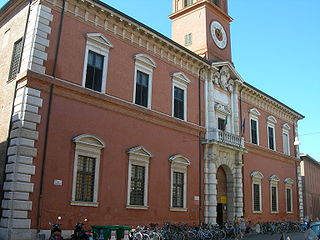
The Palazzo Paradiso is a Renaissance palace located on Via Scienze #17 in the medieval center of Ferrara, region of Emilia-Romagna, Italy. Adjacent to the historic Jewish ghetto of Ferrara, it houses:

The Palazzo Pendaglia is a 15th-century, Gothic-style palace located at Via Sogari #3, in Ferrara, Italy. In 2015, it houses an institute for training restaurant and hotel staff.

The Palazzo di Giulio d'Este is a palace located on Corso Ercole I d'Este #16 in Ferrara, Italy.

Palazzo Prosperi-Sacrati is a Renaissance-style palace located on Corso Ercole I d'Este in Ferrara, region of Emilia Romagna, Italy. The palace with its protruding marble portal and balcony, and with a corner balcony and pilaster on the corner with Corso Biagio Rossetti, was designed and built in 1493-1498 by Biagio Rossetti as part of the Addizione Erculea. It is flanked on the ground floor by marble pilasters. It is across the Corso Rossetti from the lateral facade of the Palazzo dei Diamanti.
The Palazzo Zagnoni, also known as Palazzo Spada, is a Neoclassic-style palace located on Via Castiglione 25–27, in Bologna, region of Emilia-Romagna, Italy.
The Palazzo Bolognetti is a Renaissance style palace located on Via Castiglione #1, in central Bologna, region of Emilia Romagna, Italy. The palace is adjacent to the Palazzo della Mercanzia.
The Palazzo da Mosto is a Renaissance-style palace located on Via Giovanni Battista Mari 7 in the northwest of the historic center of the town of Reggio Emilia in Italy.
